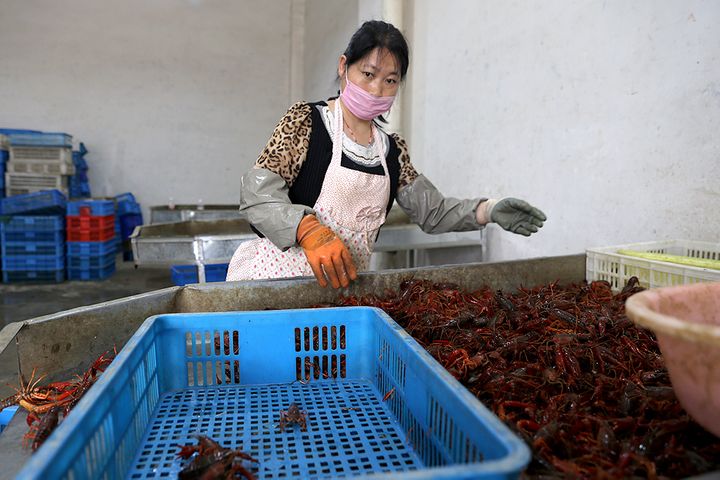 Hubei's Crayfish Also Feel Pinch as Covid-19 Blocks Feed, Sales
Hubei's Crayfish Also Feel Pinch as Covid-19 Blocks Feed, Sales(Yicai Global) Feb. 20 -- The novel coronavirus epidemic may also take its toll on the crawfish so favored by Chinese eaters and delay their market arrival while inflating their prices as shutdowns to check the spread of the virus are also choking off feed to the mini-lobsters and keeping them from eatery plates.
Many regions in Hubei province have strict closure policies in place to try to curb the epidemic and these have also heavily impacted the local crawdaddy sector. Since Hubei province produces half of the country's total of 'little dragon shrimp,' the outlook for mudbugs this year is accordingly rather less than optimistic.
"March used to be the peak season for crayfish sales, but most of the local aquatic wholesale markets have been closed down this year, and business owners have suffered great losses," crawdad sector researcher Hu Shengxiang told Yicai Global.
Farm workers who were supposed to return to the job after the Spring Festival break were forced to stay in their hometowns because of the local lockdown, which has caused some farmers of the crimson-cooked crustaceans to lack manpower, Hu said.
The crawfish sector has grown into an emerging one with an annual output value of CNY369 billion (USD52.6 billion), fed by a rapid rise in demand. Hubei had 480,667 hectares out of the 840,667 devoted to cultivation of the culinary arthropods in China in 2018, a year in which the nation turned out about 119 million tons of them, to which total Hubei contributed 81.24 million. The province's major production areas were all in the places most affected by the virus, according to data from China's agriculture and rural affairs ministry.
Crawdaddy Crunch
Feed shortages are not the only problem bedeviling the crayfish industry. Not only do traffic restrictions prevent timely delivery of the highly-perishable creatures, but even where this is not the case, buyers are scarce because the pestilence has left most restaurants either devoid of customers or shuttered, several farmers told Yicai Global.
If the epidemic continues into May, nearly four-fifths of crawfish farmers will be sorely affected, Hu said.
The processing industry is also suffering. Hubei Communications Investment & Laker Agricultural has not started production and cannot fulfill CNY50 million (USD7.1 million) in orders, including CNY20 million for its overseas clientele, Zheng Yulin, the company's general manager, told Yicai Global.
Hubei already has a full industry chain from crayfish hatcheries, feed factories, finished product processing and finished product logistics companies after years of development, and so the coronavirus should not sound the death knell on the central province's cultivation, several local farmers said, adding the province's total production this year will not differ much from last year's.
The domestic crayfish market has hit short-term sales bumps, but in the long run, China's diners still have a huge appetite for mudbugs, and prices may soon return to normal, Hu noted.
Editor: Tang Shihua, Ben Armour